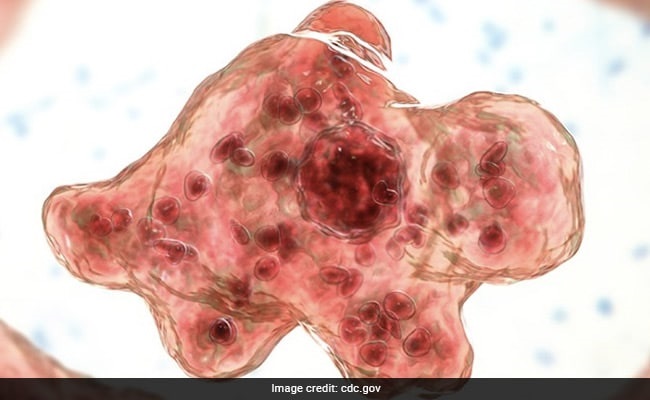
നൈഗ്ലെറിയ ഫൗവ്ലേറി എന്ന അപകടകാരിയായ സൂക്ഷ്മാണുവിന്റെ ആക്രമണം മൂലമുണ്ടാകുള്ള ആദ്യ മരണം സ്ഥിരീകരിച്ച് ദക്ഷിണ കൊറിയ. അപൂർവമായി കാണപ്പെടുന്ന ഈ അമീബയുടെ ആക്രമണം മൂലമുണ്ടാകുന്ന അസുഖത്തെ തുടർന്ന് അൻപതുകാരനായ വ്യക്തിയാണ് മരണപ്പെട്ടതെന്ന് കൊറിയ ടൈംസ് റിപ്പോർട്ട് ചെയ്തു. തായ്ലാൻഡിലെക്കുള്ള യാത്രയ്ക്കിടെയാണ് അൻപതുകാരന് രോഗബാധയുണ്ടാകുന്നതായി സംശയിക്കുന്നത്. രോഗലക്ഷണങ്ങൾ പ്രകടിപ്പിച്ച് പത്ത് ദിവസത്തിനകം തന്നെ മരണം സംഭവിക്കുകയായിരുന്നു
മരിച്ച വ്യക്തി ഡിസംബർ 10ന് കൊറിയയിൽ എത്തും മുൻപ് നാല് മാസത്തോളം തായ്ലൻഡിൽ താമസിച്ചിരുന്നതായി കൊറിയ ഡിസീസ് കണ്ട്രോൾ ആന്റ് പ്രിവൻഷൻ ഏജൻസി വ്യക്തമാക്കി. കൊറിയയിൽ എത്തിയ ശേഷമാണ് നൈഗ്ലെറിയ ഫൗവ്ലേറി സ്ഥിരീകരിക്കുന്നത്.
‘തലച്ചോറ് ഭക്ഷിക്കുന്ന അമീബ’ എന്നാണ് നൈഗ്ലെറിയ ഫൗവ്ലേറി അറിയപ്പെടുന്നത്. ഈ അസുഖം ശരീരത്തെ ബാധിച്ചതിന് പിന്നാലെ തലവേദന, പനി, ഛർദി, സംസാരിക്കാൻ ബുദ്ധിമുട്ട്, കഴുത്തിൽ മുറുക്കം എന്നിവ അനുഭവപ്പെടും. ഈ ലക്ഷണങ്ങളെല്ലാം ശ്രദ്ധയിൽപ്പെട്ട ദക്ഷിണ കൊറിയൻ സ്വദേശി വൈദ്യസഹായം തേടുകയും ഉടൻ തന്നെ അടിയന്തര ചികിത്സാ വിഭാഗത്തിൽ പ്രവേശിപ്പിക്കപ്പെടുകയും ചെയ്തു.
South Korea Registers First Death Linked to ‘Brain-Eating Amoeba’
A man in his 50s passed away from the infection of Naegleria fowleri, commonly referred to as the “brain-eating amoeba,” after returning from Thailand, marking South Korea’s first case of the deadly disease, according to The Korea Times.
A Korean national died after returning from Thailand, according to a report in the News Outlet, which cited the Korea Disease Control and Prevention Agency. The man spent a total of four months there before returning to Korea two weeks ago, on December 10.
The patient began to show symptoms of meningitis, such as headaches, fever, vomiting, slurred speech, and stiffness of the neck, on the evening of his arrival, and was transferred to an emergency room the next day.
The next day, he was admitted to a hospital, and he passed away on December 21.
The cause of his death was determined by genetic testing on three different infections that cause Naegleria fowleri, according to the Korean health agency. Testing revealed that the man’s body contained a gene that was 99.6% identical to one discovered in a meningitis patient who had been reported abroad.
This is the first known infection from the disease in South Korea. Although the KDCA has not yet identified the precise method of transmission, it has highlighted that the two main sources of infection are swimming in contaminated water and nasal rinsing with infected water.
According to the Centers for Disease Control and Prevention, the national public health agency of the United States, Naegleria fowleri is an amoeba (single-celled living organism) that lives in soil and warm fresh water, such as lakes, rivers, and hot springs. t is commonly called the “brain-eating amoeba” because it can cause a brain infection when water containing the ameba goes up the nose. Only about three people in the United States get infected each year, but these infections are usually fatal.The first report identifying this infection was published in 1965 in Australia. The report identified three fatal infections from 1965 and one from 1961.
sourse ndtv
